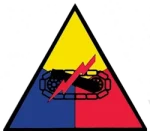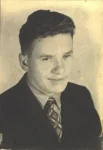S/Sgt. Henry Nelson Frees Jr. was born in Duluth, Minnesota, on July 23, 1915, to Henry N. Frees Sr. and Blanche Sawtelle-Frees and had three brothers. His family resided at 411 North Second Avenue, Maywood, Illinois, and he graduated from Lincoln School and Proviso Township High School in 1935. After high school, he attended Elmhurst College, Elmhurst, Illinois, and played tennis. When the Selective Act became law on October 16, 1940, Henry registered for the draft and named his mother as his contact person. He also married Elenore Groh, but when the marriage took place is not known.
Henry was inducted into the US Army on September 23, 1942, in Chicago. Since he scored high Army General Classification Test, he was given the opportunity to join the Army Air Corps. Accepting the appointment, he was sent to Smyrna Airfield, Smyrna, Tennessee, from October 8, 1942 to November 12, 1942; Selman Field, Monroe, Louisiana, navigator training, November 13, 1942 to January 27, 1943; Army Air Force Flight Training Center, Coral Gables, Texas, January 29, 1943 to March 18, 1943; Keesler Field, Mississippi, March 19, 1943 to April 23, 1943; Scott Field, Illinois, April 29, 1943 to October 25, 1943; Truax Field, Wisconsin, October 27, 1943 to December 5, 1943; Clovis Airfield, New Mexico, December 17, 1943 – September 1, 1944; and Herington Airfield, Kansas, September 2, 1944 to September 12, 1944. During his training he qualified as a radioman.
Sometime during his training he was assigned to the 45th Bomb Squadron, 40th Bombardment Group, 58th Bombardment Wing, 20th Air Force (Very Heavy) as a replacement. The unit flew bombing missions, in B-29s, Thailand, Manchuria, Borneo, Formosa, Burma, Malaya, Japanese-occupied China, Singapore, Saigon and Cam Rahn Bay, French Indochina.
On August 14, 1945, after atomic bombs had been dropped on Hiroshima and Nagasaki, Japan announced that it would surrender to the United States. It was after the announcement that American B-29s began flying missions to Japan and other countries where Prisoner of War camps were located. Henry’s plane left Tinian Island on a food drop to Fukuoka #9 POW Camp, Japan, when the plane’s wing apparently clipped Mount Sobo (also known as Mt. Sobzan) and crashed into the southern slope of the mountain on August 30, 1945. The site was stated to be between Miyalaki and Oitakens, Japan. When teams were sent to the area to recover the bodies of the crew, they could not find the crash site so the men were listed as Missing.
Elenora Frees was Henry’s contact person and was notified that her husband was missing.
MRS ELENORA L FREES=
5424 WEST COURTLAND STREET CHICAGO ILL=
I REGRET TO INFORM YOU REPORT RECEIVED STATES YOUR HUSBAND STAFF SERGEANT HENRY N FREES MISSING IN ACTION OVER JAPAN SINCE THIRTY AUGUST IF FURTHER DETAILS OR OTHER INFORMATION OF HIS STATUS ARE RECEIVED YOU WILL BE PROMPTLY NOTIFIED=
ULIO THE ARJUTANT GENERAL
A letter followed the telegram.
Mrs. Elenora Frees
5424 Courtland Street
Chicago, Illinois
Dear Mrs. Frees:
This letter is to confirm my recent telegram in which you were regretfully informed that your husband, Staff Sergeant Henry F. Frees, 16, 079, 249, Air Corps, has been reported missing in action since 30 August 1945 over Japan.
I know that added distress is caused by failure to receive some information or details. Therefore, I wish to assure you that at any time additional information is received it will be transmitted to you without delay, and, if in the meantime no additional information is received, I will again communicate with you at the expiration of three months. Also, it is the policy of the Commanding General of the Army Air Forces upon receipt of the “Missing Air Crews Report” to convey to you any details that might be contained in that report.
The term “missing in action” is used only to indicate that the whereabouts or status of an individual is not immediately known. It is not intended to convey the impression that the case in closed. I wish to emphasize that every effort is exerted continuously to clear up the status of our personnel. Under war conditions this is a difficult task as you must readily realize. Experience has shown that many persons reported missing in action are subsequently reported prisoners of war, but as this information is furnished by countries with which we are at war, the War Department is helpless to expedite such reports. However, in order to relieve financial worry, Congress has enacted legislation which contains in force pay, allowances and allotments to dependents of the personnel being carried in a missing status.
Permit me to extend to you my heartfelt sympathy during this period of uncertainty.
Sincerely yours,
(signed)
J. A. ULIO
Major General
The Adjutant General.
At some point she received a letter stating that based of evidence the Army was making a “finding of death” in her husband’s case. It is not known when she received the letter.
The American Graves Registration Service sent Team #3, Detachment D, 108th Graves Registration Platoon to Fukuoka, Kyushu, Japan to investigate the report of graves of twelve American Air Corps personnel located near the summit of Mt. Sobo, Miyazaki Prefecture. On the 27th, the team questioned the local residents. It was told that at about 10:00 am on August 30, 1945, a B-29 crashed into Mt. Sobo near the summit in foggy weather. No parachutes had been seen by the locals. The local police and firemen went to the crash site, put out the fire, and buried the bodies of twelve Americans. On the 28th, at 7:00 am, the team went up the mountain and reached the crash site at 11:30 am and found the wreckage spread over nearly an acre with all the trees in the area destroyed. This meant the plane hit the mountain at a high rate of speed.
The team found the graves of six of the men reported to have been on the plane. The graves were eight yards apart and laid out in the shape of a plane. Each grave had a stake with the words “grave marker” in Japanese. The remains were shallows and the remains were exhumed from the graves. Each grave also had a number of crude wooden crosses marking them that indicated the number of bodied buried in each grave. It appears that Henry was the only man to be buried in the grave his remains were exhumed from. The remains of the crew members were recovered – many had fatigues and shoes but were in an advance state of decomposition – and buried in the United States Armed Forces Cemetery #1, Yokohama, Japan. Records show that Henry was buried in Row 33, Grave 1569. Henry and Lt. Williamson would be the last two men to be identified by dental records.
During this time, Elenora had moved to California and remarried on January 17, 1948, making Henry’s mother his next of kin. She received a letter that gave her information on her options for Henry’s final burial. She was asked to fill-out and return to the Office of Quartermaster General, Washington DC, indicating where she wanted her son buried. The form was received by the OQMG on April 5. 1949, indicating that his mother wanted Henry to be buried in Rock Island National Cemetery, Rock Island, Illinois.
Henry’s casketed remains were placed on the USAT Lt. George W. Boyce on May 21, 1949, and arrived at Ft. Mason in the San Francisco Port of Entry on June 6, 1949. From San Francisco, by train with a military escort, his casket was sent to the Quartermaster Corps Distribution Center #8 Chicago, and arrived on June 10th. His casket was sent on the Chicago, Rock Island & Pacific Railroad to Rock Island, Illinois, arriving at 6:35 am, July 23, 1949. He was buried the same day in Section E, Site 191, in the Rock Island National Cemetery. His mother also received his Air Medal, with three Oak Leaf Clusters, Purple Heart, three Distinguished Unit Citations, and his Flying Cross.







